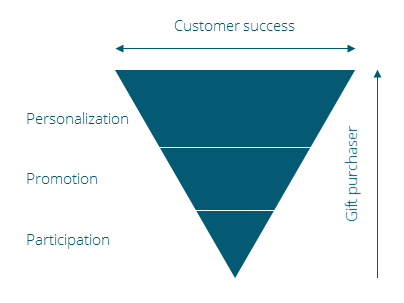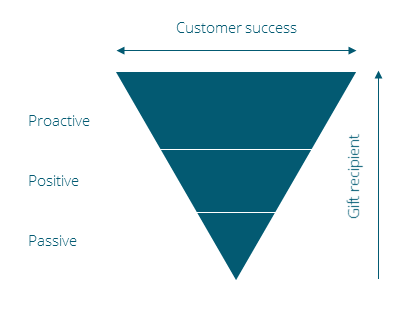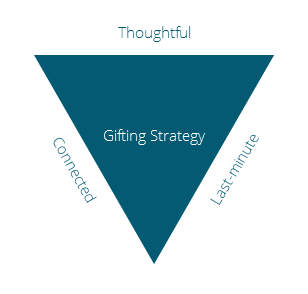Viewpoint: The 3 Pyramids of Customer Success in E-Gifting
Maximizing a retailer’s customer success in e-gifting is about creating a holistic experience that speaks to the uniqueness of this transaction. On the digital consumer side, the gifting workflow should enable a hassle-free but thoughtful purchase for the gift shopper and expand that opportunity into active sales and engagement with the gift recipient.
As an industry, we understand how important it is for a retailer to speak to its customers on an emotional level. When a consumer feels a connection, that emotion inspires repeat purchases and bigger tickets over time.
Here at SmartGift, we like to think of gifting as an integral part of a retailer’s overall strategy that brings incremental revenues and relationships by serving gift shoppers’ and recipients’ desired outcomes. We pioneered SKU-level e-gifting to maximize the gifting transaction in every single way—its thoughtfulness, its flexibility, the ability to capture crucial data and promote a new channel to market and sell more product. With SKU-level e-gifting, gift shoppers buy any product at their favorite retailers online as a gift and recipients choose their product preferences, such as size, color, style, or, exchange the gift for the retailer’s e-gift card—all before the gift ships.
We developed the below three pyramids of gifting as useful tools to help our retail partners understand where they are in their e-gifting customer success journey. You can use them, too. Although we are firm believers in SKU-level e-gifting, you can apply the principles of engagement into any digital gift card strategy. The higher up your customers are on your pyramid (near the base of the inverted pyramids), the higher their lifetime value and the lower your cost of customer acquisition.

Figure 1: Retailer’s Customer Success and Gift Purchaser Path
Figure 1: Retailer’s Customer Success and Gift Purchaser Path
Participation: A retailer that’s only participating in gifting is not actively pursuing the gift shopper or facilitating the gifting experience beyond offering e-gift cards. It is not creating additional revenue from its gifting business.
Promotion: A retailer that’s promoting gifting with year-round occasion-based gift guides and marketing is on the path to addressing gifting needs and attaining more gift shopper traffic.
Personalization: By enabling a dedicated workflow for gifting by which customers can buy and send thoughtful item-level gifts with ease, a retailer offers a differentiated and personalized gift shopping experience. The retailer understands that gifting is anxiety-ridden and assists gift shoppers on the purchase path.

Figure 2: Retailer’s Customer Success and Gift Recipient Path
Figure 2: Retailer’s Customer Success and Gift Recipient Path
Passive: The retailer hasn’t connected with the gift recipient on any level in the transaction. It has ignored the opportunity to engage and build a relationship.
Positive: The retailer has positioned itself in front of the gift recipient by delivering the e-gift card. It has minimal insight into the recipient (mostly email) and that’s where the engagement ends. It is positive in the sense that a communication flow has been established.
Proactive: The retailer recognizes and celebrates the recipient as a potential customer, a brand ambassador and a loyalist in the making. It utilizes all the tools in its reach, such as personalized promotions or localized shopping experiences, to bond with the recipient. With SKU level e-gifting, the brand has powerful insights into the gift recipients. It proactively delivers the e-gift and also offers choice of complementary products, upgrades and promotions on specific product categories or on special recipient occasions. The retailer engages with the recipient and learns more about her preferences with each interaction. It makes sure that the gift delivery interaction with the recipient counts and converts.
The Three Pillars
In the first two pyramids, we looked at retailer success with the two actors in the gifting equation; the gift purchaser and the gift recipient. The third pyramid forms the basis of a sophisticated, innovative and complete gifting strategy. It’s the sum of the first two pyramids and is based along three dimensions:

Figure 3: The 3 Pillars of Gifting Strategy
Figure 3: The 3 Pillars of Gifting Strategy
Thoughtful: The trophy value of a gift is at the heart of this exchange. “I thought about you”; “I thought you might like this” are fundamental to gifting.
Last-minute: More than 45 percent of gift purchasing is last-minute regardless of the occasion. This makes it even more important that the last-minute gift is delivered with thought and meaning. SKU-level e-gifting (or a personalized gifting strategy) enable the retailer to capture last-minute gifting volume, drive revenue and retention, and ensure that the gift purchaser is happy with the experience. Utility plus magic win.
Connected: Any successful strategy needs to be an integrated part of the wider business. Gifting has traditionally operated on the sidelines. Many retailers have incorporated gift cards (plastic and digital) into their overall marketing and sales strategies, but e-commerce provides opportunities to go further and improve the gifting experience for purchasers and recipients. One way is by tapping into recipient preferences using SKU-level e-gifting, which can boost revenue and provide valuable customer data to increase the lifetime value of gift givers and recipients.
Monika Kochhar co-founded SmartGift, which brings product level gifting to e-commerce. As CEO, she leads SmartGift’s team and is responsible for strategy, client acquisition and channel partnerships. Kochhar has previously advised startups into strong exits and spent time on Wall Street trading tech and telecom. She contributes regularly to publications and co-authored “This is a Gift: An E-Commerce Manager’s Guide to Gifting”. She is a frequent speaker at events and conferences as an expert on gifting, e-commerce and female entrepreneurship. She can be reached at [email protected].
In Blogs & Viewpoints, prepaid and emerging payment professionals share their perspectives on the industry. Paybefore endeavors to present many points of view to offer readers new insights and information. The opinions expressed in Viewpoints are not necessarily those of Paybefore.












































